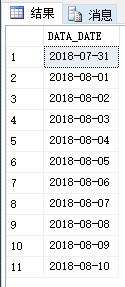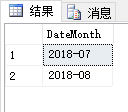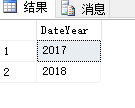Background: in many statistical reports, you need to enter start and end dates to query data according to different time units, and the displayed column names are your dynamic time units. Your table data is saved by the day, so you may need to do some sql functions or stored procedures to implement it.
1. Get each day in the range according to the start and end dates, and return as the result set (function)
create function [dbo].[fn_GetDateRange](@DATE_START datetime, @DATE_END datetime) RETURNS TABLE AS RETURN ( SELECT convert(char(10), DATEADD(dd, number, @DATE_START),120) AS DATA_DATE FROM master.dbo.spt_values as spt WHERE type = 'p' AND number <= DATEDIFF(DAY, @DATE_START, @DATE_END) ) GO
select * from fn_GetDateRange('2018-07-31','2018-08-10')Results:

2. Get the week in the range (including the start and end dates of the current week) according to the start and end dates, and return it as the result set (stored procedure)
CREATE PROCEDURE [dbo].[GetWeekRange]
@tmpDate datetime, @DATE_END datetime
AS
BEGIN
SET DATEFIRST 1
DECLARE @index INT
DECLARE @table TABLE
(
WeekTimes INT ,
FirstDay datetime ,
EndDay datetime
)
DECLARE @YearFistWK INT
SET @YearFistWK= DATEPART(dw, @tmpDate)
SET @index = ( SELECT DATEPART(WEEK, @tmpDate))
IF ( @YearFistWK = 7 )
BEGIN
SET @index = @index + 1
END
WHILE @tmpDate <= @DATE_END
BEGIN
INSERT INTO @table
SELECT @index ,
a.FirstDay ,
b.EndDay
FROM ( SELECT 1 AS ID ,
DATEADD(wk, DATEDIFF(wk, 0, @tmpDate), 0) AS FirstDAy
) a
LEFT JOIN ( SELECT 1 AS ID ,
DATEADD(wk,
DATEDIFF(wk, 0, @tmpDate),
6) AS EndDay
) b ON a.ID = b.ID
SET @tmpDate = DATEADD(DAY, 7, @tmpDate)
SET @index = @index + 1
END
SELECT WeekTimes, CONVERT(varchar(100), FirstDay, 23) FirstDay,CONVERT(varchar(100), EndDay, 23) EndDay
FROM @table
END
GOexec GetWeekRange '2018-07-31','2018-08-10'
Results:

3. Get the months in the range according to the start and end dates, and return as the result set (stored procedure)
CREATE PROCEDURE [dbo].[GetMonthRange]
@tmpDate datetime, @DATE_END datetime
AS
BEGIN
DECLARE @table TABLE
(
DateMonth datetime
)
WHILE @tmpDate <= @DATE_END
BEGIN
INSERT INTO @table
SELECT DATEADD(mm, DATEDIFF(mm, 0, @tmpDate), 0) AS DateMonth
SET @tmpDate = CONVERT(varchar(7), DATEADD(mm, 1, @tmpDate) , 120) + '-01'
END
select CONVERT(varchar(7), DateMonth, 23) DateMonth from @table
END
GOexec GetMonthRange '2018-07-31','2018-08-10'
Results:

4. Get the year in the range according to the start and end dates, and return as the result set (stored procedure)
CREATE PROCEDURE [dbo].[GetYearRange]
@tmpDate datetime, @DATE_END datetime
AS
BEGIN
DECLARE @table TABLE
(
DateYear datetime
)
WHILE @tmpDate <= @DATE_END
BEGIN
INSERT INTO @table
SELECT DATEADD(yy, DATEDIFF(yy, 0, @tmpDate), 0) AS DateYear
SET @tmpDate = CONVERT(varchar(4), DATEADD(yy, 1, @tmpDate) , 120) + '-01-01'
END
select CONVERT(varchar(4), DateYear, 23) DateYear from @table
END
GOexec GetYearRange '2017-08-31','2018-08-10'
Results:

There should be better ways. I hope you guys will give me some advice